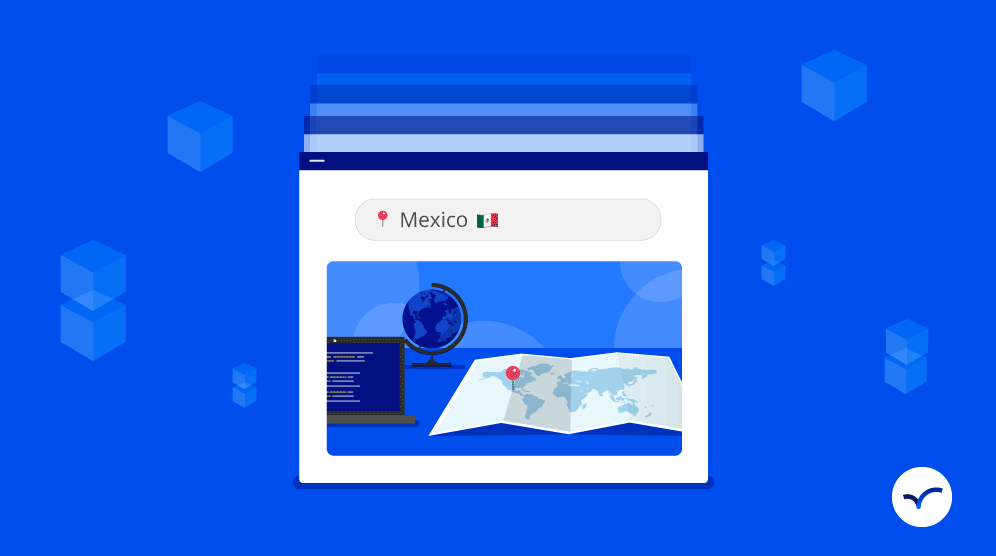If you’re looking to set up an engineering hub outside the US, Mexico might be a great option to consider. Mexico has been attractive to U.S. companies interested in saving money on production and personnel costs since NAFTA was signed in 1994.
Mexico is only a five-hour flight from New York, graduates more engineers than the United States, and is predicted by Goldman Sachs to be the fifth biggest economy in the world by 2050. Mexico received almost one-quarter of all VC investment in Latin America in 2017 and the Mexican government has committed over $600 million to startups since 2014.
Mexico, whose second most populated city, Guadalajara, is nicknamed “the Mexican Silicon Valley,” is known worldwide for the development of its software industry. Mexico boasts plenty of high-quality STEM talent, a low cost of living, and tax incentives aplenty for tech companies.
Scroll down to see why for these reasons and more you should consider Mexico as a potential tech hub location and/or a great source for remote developers.
A quick note before we start: this post is designed to give you a snapshot of Mexico’s suitability as an engineering hub location, but should not be relied upon instead of seeking professional advice specific to your situation.
Looking for top talent fast? See how Arc can help you:
⚡️ Find developers, designers, marketers, and more
⚡️ Freelance or full-time remote + fully vetted
⚡️ Save up to 80% with global hires
Hire top talent with Arc risk-free →
Availability of STEM Talent in Mexico
Compared to nearby Argentina, Mexico is brimming with STEM talent. On a per capita basis, Mexico produces more STEM graduates than the United States, and in overall terms is in the top 10 STEM graduate-producing countries in the world.
There are many prestigious programs for computer science in Mexico, including programs at: the Monterey Institute of Technology and Higher Education, the National Autonomous University of Mexico, the University of Guadalajara, the National Polytechnic Institute, the University of Guanajuato, the Autonomous University of Nuevo Leon, and the Metropolitan Autonomous University.
Developer Talent Pool
In 2018, there were 223,398 developers from Mexico — the second highest in Latin America — second only to Brazil in a Stack Overflow survey. According to SkillValue’s 2019 Report, Mexico ranked second in terms of the number of best developers based on 550+ technical assessments.
Gartner Inc, an IT service management company, ranked Mexican IT in the top three globally in terms of offshoring options in the tech industry and noted that Mexico’s rapid expansion was three times the global average.
Read More: Contract to Hire: The Flexible Remote Engineering Team Scaling Solution
Existing Mexican Tech Hubs
Red Door
In an NPR interview, the CEO of Red Door Interactive explained why they chose Mexico:
We have this — I don’t know — sibling to the south, so to speak. And so I figured we weren’t really taking advantage of it. This person’s super talented, and they’re exactly what we’re looking for. And they happen to be, in this case, in that environment — less expensive. That’s OK.
3D Robotics
For Tim McConnell, 3D Robotics’ Director of Engineering, Mexico is great because:
If you want to build 10,000 of something a month and it’s the exact same product and it doesn’t change, that’s an easy thing to do in China. But if you want to build only 100, make some changes and build 100 more, you’re better off “nearshoring” in Mexico.To be able to drive down there with your engineers, talk to the manufacturing folks, give feedback back and forth results in fast turnaround on design changes and prototypes.
Microsoft
During a Microsoft conference announcing a new data center in Mexico, César Cernuda Rego, president of Microsoft Latin America said (note — translated with Google Translate from Spanish original):
The decision to invest in Mexico compared to other Latin American countries, has several reasons, but fundamentally there is a young population in Mexico. There is only one future, which is the present and is digital. Mexico is very well positioned to harness the power of new technologies.
IBM
In a 2011 press release, IBM gave this reasoning for why they chose to collaborate with the University of Guadalajara on their Smarter Cities Exploration Center:
Guadalajara is Mexico’s second largest city. It is known as Mexico’s leading IT hub and one of the most prestigious IT regions globally, as it is home to a strong electronics industry, and has earned recognition as the Mexican capital of IT and software development. Guadalajara was considered the city of the future by FDI Magazine’s 2008 studies, due to its largely young population, its low unemployment, the large inflow of recent foreign investments, and the number of projects it has in the pipeline.
Wizeline
Bismarck Lepe, founder of Wizeline, describes why he decided to base his startup in Guadalajara:
You’re starting to get the second or third generation of technologists who have experience build[ing] scalable products. And it’s not only the talented people that are there, but the ones we can attract to live there. Wizeline now has employees from Egypt, France, Ecuador, Colombia, China, New Zealand, and, of course, the United States working at its Guadalajara offices. It’s easy to get them work visas, something that is becoming harder north of the border. And they love the quality of life in a city that is far cheaper than Silicon Valley but still has great cultural and recreational options.
Other Tech Hubs in Mexico
- Oracle
- Telmex
- Lenovo
- Cisco
- Intel
- Paystand
- Brightcove
Read More: Toronto vs Vancouver: Where to Build Your Next Remote Engineering Team
You can also try Arc, your shortcut to the world’s best remote talent:
⚡️ Access 450,000 top developers, designers, and marketers
⚡️ Vetted and ready to interview
⚡️ Freelance or full-time
Try Arc and hire top talent now →
Time Zone Overlap Between Mexico and the United States
Mexico has four time zones, three of which are more commonly used and correspond, for the most part, to U.S. time zones. These three span UTC -6, UTC -7, and UTC-8 in the fall and winter. Mexico observes daylight savings, which means that from spring until fall, Mexico’s time zones are UTC-5, UTC-6, and UTC-7.
Mexico City, central, and most of eastern Mexico observe UTC -6, while most of western Mexico, including Baja California Sur, Chihuahua, Nayarit, Sinaloa, and Sonora observes UTC -7. Baja California observes UTC -8.
While this may seem complicated, rest assured — this just means that no matter where you are in the United States or Canada, your time zone won’t be too different from your counterparts or developers in Mexico.
English Proficiency in Mexico
According to EF’s English Proficiency Index in 2019, Mexicans scored 48.99 out of a possible 100 points — ninth in North America. Two of the three largest tech hubs in Mexico, Monterrey and Guadalajara, have the highest level of English proficiency in the country.
Read More: Canada, Mexico, and Argentina: Where to Build Your Engineering Hub
Mexican Lifestyle
Mexico ranks second highest in the Happy Planet Index with a score of 40.7. Its well-being score is much higher than that of the United States despite Mexico’s economy is almost five times smaller. For context, the United States ranked 108th out of 140 and Norway 12th.
Cost of Living in Mexico
The cost of living is generally very affordable by U.S. and Canadian standards. A one-bedroom apartment in the center of Mexico City will cost $500USD. In Guadalajara, a major tech hub, an equivalent apartment in the city center rents for roughly $194 to $242.
Mexican Remote Developer Salaries
Mexico is known for its savings in terms of hiring tech talent compared to the United States or Canada. Below are desired annual salaries in U.S. dollars for remote developers based in Mexico.
- Front-end Developer: $73,188
- Back-end Developer: $70,323
- Mobile App Developer: $67,557
- DevOps Engineer: $96,735
Why Mexico is a Great Location for an Engineering Team or Hub
In a recent NPR article on Tijuana’s tech boom, Stacey Vanek Smith and Constanza Gallardo of Planet Money discussed why American companies are moving to Mexico. Vanek Smith brought up that dozens of American companies have set up shop in the Baja region in the past five years to specifically hire for computer science jobs and tech jobs while Gallardo mentioned that most things are cheaper for companies doing business in Mexico, compared to the United States.
Furthermore, Gallardo noted that the Mexican government recently introduced tax incentives for new businesses opening up along the border with the United States and that the cost of living is a lot lower in Mexico — as are staffing costs.
These factors — cheaper operating costs, cost of living, and personnel costs — along with convenient time zone overlap as well as ease of travel between the United States and Mexico are why Mexico would make a great engineering hub.
Read More: Ukraine, Poland, Estonia, Romania: Where to Build Your Engineering Team
All About Employment in Mexico
Employee Benefits
Mexican employees are entitled to:
- Severance pay of three months of salary plus prorated mandated federal benefits.
- Maximum working schedule (48 hours per week) with one day of rest per week. If the employee works their seventh day of rest, they are entitled to a Sunday bonus of 25% of their normal daily salary.
- Annual paid vacation (six days a year during their first year with two additional days until the end of their fourth year, whereupon they receive two additional vacation days every five years).
- Vacation premium (an amount paid to an employee on top of his/her regular pay for vacation days) equal to 25% of the amount received during vacation days.
- A 13th month mandatory Christmas bonus equivalent to wages for 15 days of work.
- Profit sharing of 10% of declared company profits.
- Maternity and paternity leave.
Statutory Labor Requirements
Employees in Mexico are classified as unionized and non-unionized employees, trust employees, indefinite, definite, and seasonal employees, and independent contractor/self employed.
All employees other than independent contractors/self employed employees are entitled to the same employment benefits and conditions — employment relationships in Mexico are generally for an indefinite term. The minimum wage, as of January 2020, is equivalent to USD $4.94 per day in a non-Border zone and USD $7.44 per day in the Border zone.
Employment relationships over 180 days can have a probation period that should not exceed 30 days while the initial training period cannot exceed 90 days. If the position is managerial/directorial, administrative, or involves specialized or professional activities, a probation period of up to 180 days is possible.
Mexican National Holidays
There are six paid national holidays and a Change of Federal Power Day every six years with the inauguration of a new president.
Read More: Building an Engineering Team in Argentina: Everything You Need to Know
Government Incentives
Tax Incentives
In December 2018, the Mexican government published a special decree with tax incentives for businesses operating in the northern border zone of Mexico for 2019 and 2020. These incentives include tax credits, which effectively reduce the income tax rate from 30% to 20% for legal entities, and a reduced value added tax (VAT) rate of 8%.
In addition, depending on where you want to base your hub, some state governments may also grant tax incentives such as reduced prices for land and reductions in property and payroll taxes.
Ease of Obtaining Visas
Before a foreign national can work in Mexico, their employer must be registered with the National Migratory Institute (NMI) and submit a request for a work visa that includes their employer’s registration with the NMI, a job offer, and passport.
Once the NMI grants a work permit, the foreign national needs to schedule an appointment at a Mexican Consulate abroad and provide it with a visa resolution. After the foreign national is interviewed to verify his or her information, they will receive a provisional visa to enter Mexico.
The provisional visa should be exchanged for a visa identification card within 30 business days of arriving in Mexico. Your non-Mexican employee will not be able to enter Mexico as an employee if you are not registered with the NMI and if they don’t have a formal job offer from you. Visas can be renewed by foreign national employees without leaving the country.
Visas can take up to three to six months to process and there are economic sanctions for both the employer and employee for violating employment visa laws.
Ease of Relocating Senior Staff
There are no restrictions on the nationality of managers and company directors other than their legally being allowed to work in Mexico, which is having the appropriate immigration documents discussed above.
According to Mexican law, 90% of employees hired by a Mexican employee must be Mexican nationals — general directors and managers, however, do not count against you in terms of the number of foreign employees that can be employed.
Read More: Building an Engineering Team in Brazil: Everything You Need to Know
Looking for top talent fast? See how Arc can help you:
⚡️ Find developers, designers, marketers, and more
⚡️ Freelance or full-time remote + fully vetted
⚡️ Save up to 80% with global hires
Hire top talent with Arc risk-free →
Regulatory Environment in Mexico
Legal System
Mexico’s labor laws are pro-employee and apply to all those who work in Mexico, regardless of Mexican nationality. They also cover Mexican citizens working abroad if they are employed by a Mexican company. Every employee in Mexico must enter into a written individual employment agreement that states the terms and conditions of employment.
Ability to “Do Business”
If you have employees in Mexico, you’re responsible for a payroll tax of between 1.5 to 3 percent of total payroll as well as social security contributions for tax resident employees. A tax resident employee is someone who is in Mexico for more than 183 days or his or her salary is paid by a Mexican resident. Your employee is considered a non-tax resident employee if they are not in Mexico for more than 183 days and his or her salary is paid by a foreign resident.
Your social security contributions for Mexican employees will be about 26.95 to 35.14% of your employee’s total consolidated income, which includes: 1.75% for disability and life insurance, 2 to 3.15% for retirement pensions, unemployment, and old age, 21.65% for health and maternity insurance, 0.54 to 7.59% for occupational risk, and 1% for daycare.
If your company has its main administration center in Mexico or if its effective management is in Mexico, your company is considered a tax resident business. If you’re a non-tax resident business, you can be subject to 30% income tax on net income if you have a permanent establishment in Mexico, including offices, branches, and mining sites.
If a non-tax resident company does not have a permanent establishment in Mexico, income from Mexican sources is taxed, although the rate varies, although it’s generally around 25%. Double tax treaties, however, can reduce or eliminate the taxation.
Making Payments as a Multinational Enterprise
If your head office is based in the United States or outside of Mexico, to pay your employees you need to complete three steps. First, you need to incorporate and register with the National Registry of Foreign Investment.
Then, you will obtain your business’ tax identification card from the Federal Taxpayers registry. Finally, you’ll need to register as an employer with the Mexican Social Security and receive tax registration from the governing bodies in your local jurisdiction.
This allows you to open your Mexican bank accounts, which are mandatory for making payments to both employees and the government’s social security and taxation agencies.
If you want to open a bank account in Mexico, your company must supply a Tax Identification Number, proof of address, banking or commercial references, and formal identification of the organization’s legal representatives or guarantees of a power of attorney.
Read More: Is Your Developer Ready for Remote Work? 14 Key Interview Questions
Why Hire Remote Developers from Mexico
Methods of Payment
Cross-Border Payment Options
You can pay remote developers from Mexico using Xoom, Wise, international wire transfer, Payoneer, and PayPal.
Preferred currencies
Mexico’s official currency is the Mexican peso, so developers will prefer to be paid in Mexican pesos.
The Legal Side of Hiring a Remote Developer from Mexico
As with Argentina, you can legally hire a remote developer to work for you without jumping through a lot of hoops. However, Mexican employment rights are inalienable, which means that you will be subject to Mexican labor laws, which are protective of employees.
While going through service providers or commission agents may mean Mexican employment rights would not apply in principle, labor courts could determine there was nonetheless an employment relationship if personal services were rendered, services were subordinated by a legal entity or an individual, and if salary was paid.
Read More: Freelance Web Developer vs Dev Agency: Which is Best for My Project?
Cultural Expectations
Employer-Employee Relations
In Mexico, lunch can be a long social gathering that starts later in the day. Instead of eating at noon or 1:00, lunch can start at 2:00 and last until 4:00. While this won’t affect your developer’s ability to ship code and get the job done, you may want to keep this in mind when scheduling meetings.
Mexican work culture can be more formal than that of the United States, so your developer may be more formal than you’re used to when communicating via email or messages. Another cultural difference is that indirect communication is also common — Mexicans rarely say no directly and may tactfully try to avoid any conflict or confrontation so it’s important to look for the subtext when communicating with developers.
Ironically, while work culture is more formal, references to time are more open ended in Mexico, where tomorrow may not mean tomorrow but a few days from now. Therefore, when communicating about deliverables, it’s best to be clear as to the exact day you need something shipped.
Holidays
Mexican developers will expect a minimum of six paid days off per year, per Mexican labor law. The employer needs to pay full salary and benefits for holidays.
Benefits
Remote developers expect full employment benefits according to Mexican labor laws, including paid annual leave, a 13-month bonus, and a mandatory rest day. While you may certainly offer additional perks, those are the baseline benefits any Mexican employee receives, so you need to meet those benefits at a minimum.
Note that under Mexican labor law, if your developer terminates your labor relationship for a justified cause, he or she will be entitled to receive a severance of three months’ salary, 20 days of salary for each year worked, and the accrued and proportional benefits owed to the employer. If you terminate the relationship for a justified cause expressly addressed by the Federal Labor Law, you will not be obligated to pay anything other than the accrued benefits owed to the employee.
Read More: How & Why Hiring Remote Developers Builds Strong and Diverse Teams
Hiring a Remote Full-time, Part-time, Contractor from Mexico
Whether you hire a remote full-time or part-time developer from Mexico, Mexican labor laws require that you treat them like full-time employees. However, there are exceptions for employees considered independent contractors or self-employed, which your remote developer could potentially fall into.
Under Mexican legislation, independent contractor relationships with their employers are considered a civil/commercial matter, which is ruled by civil legislation. Independent contractors are not entitled to benefit from the employment rights provided to employees under the Federal Labor Law.
However, it is important to note that whether a person is considered to be an employee or an independent contractor is determined by the legal system based on how the services are rendered.
This means that regardless of whether you call your contractor an employee or independent contractor, or the type of agreement you made, the court could still determine that your independent contractor is, in fact, an employee and should receive the benefits given to full-time employees.
Read More: US vs International Developers: Do Overseas Developers Get a Bad Rap?
Is Mexico Your Ideal Engineering Team or Developer Hub Location?
If you’re looking to establish a tech hub outside of the United States or Canada, Mexico is an attractive candidate if you don’t want to venture too far from home. Mexico boasts a large supply of high-quality STEM talent and convenient time zone overlaps with the United States.
In addition, Mexico is only a five-hour flight from New York and three from San Francisco — if you need to go to a meeting in Mexico, it’s much more convenient than flying to South America.
While Mexico’s labor laws favor the employee, they’re less stringent than Argentinian labor laws. While you do pay up to 35% in social security benefits, local salaries are lower and it’s likely easier to convince your non-Mexican employees to move to Mexico than somewhere further south.
If you’re looking to hire a remote developer from Mexico, you’ll have a ton of very qualified STEM graduates to choose from. While part-time remote employees do receive the same benefits and protections as full-time employees under Mexican labor law, independent contractors are not subject to the same legislation, which may be in your favor when hiring.
One thing to note when hiring a remote developer from Mexico is that you’ll have access to talented developers who have graduated from top computer science programs in the country and who may have worked for larger tech companies before working for you.
This means that you can hire someone familiar with U.S. company culture and norms with ample experience under their belt for less than the cost of their U.S., Canadian, or European counterpart.
If you’re considering building your tech hub in Mexico or hiring remote developers from Mexico and you have questions, feel free to get in touch.
You can also try Arc, your shortcut to the world’s best remote talent:
⚡️ Access 450,000 top developers, designers, and marketers
⚡️ Vetted and ready to interview
⚡️ Freelance or full-time








